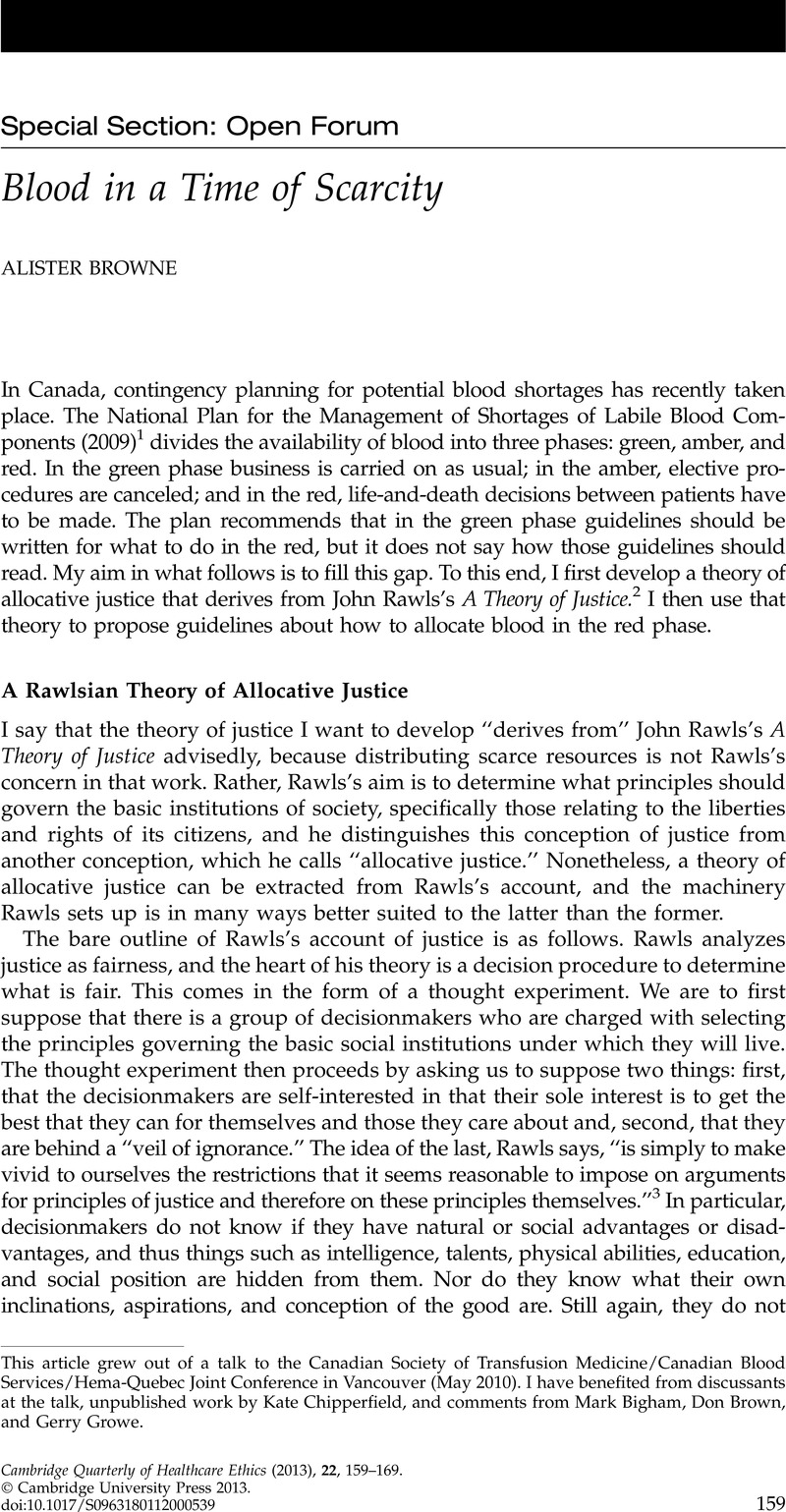No CrossRef data available.
Published online by Cambridge University Press: 14 March 2013

1 National Advisory Committee on Blood and Blood Products & Canadian Blood Services. National Plan for the Management of Shortages of Labile Blood Components. Draft 28 Sept 2009.
2 Rawls J. A Theory of Justice. Cambridge, MA: Harvard University Press; 1971.
3 See note 2, Rawls 1971, at 18.
4 See Barry B. Justice as Impartiality. Oxford: Oxford University Press; 1995, at 57–9.
5 For a discussion of this controversy, see Freeman S. Rawls. London and New York: Routledge; 2007, at 167–80.
6 And thus a Rawlsian theory of allocation cannot be criticized for relying on a mistaken decision rule, as Rawls’s original theory has been. See, e.g., Harsanyi J. Morality and the theory of rational behaviour. In: Sen A, Williams B, eds. Utilitarianism and Beyond. Cambridge: Cambridge University Press; 1982:36–62; Binmore K. Playing Fair: Game Theory and the Social Contract I. Cambridge, MA: MIT Press; 1994, at section 4.6.
7 Gibbard A. Reconciling Our Aims. New York: Oxford University Press; 2008:51–2.
8 Scanlon TM. What We Owe to Each Other. Cambridge, MA, and London: Harvard University Press; 1998.
9 BC Provincial Blood Coordinating Office. British Columbia Blood Contingency Plan. UM.CONT.0001 Ver 1.0; 30 Oct 2009, at 8.
10 One may object that this Rawlsian rejection of social criteria results in an unfair allocation on the grounds that it does not take past behavior into account and thus treats Albert Schweitzer and Adolf Eichmann on par. This would be a powerful objection if there were an alternative theory of allocation that is clearly fairer. But the only alternatives are to either draft rules to distinguish between the worthy and unworthy or allow for individual exceptions to the general rejection of social criteria. Both these alternatives open the door to arbitrariness and discrimination, and it is thus not clear that allocation policies embodying them are fairer.
11 Some studies of individuals with high-level spinal cord injuries suggestive of this conclusion are collected in Young M, Browne A. Choosing death in rehabilitation. Topics in Spinal Cord Injury Rehabilitation 2008;13(3):18–29.
12 An exception to this is when the patient is a potential organ donor. PDMs must give priority to such patients in circumstances in which doing so will maximize potential expected life years of others.
13 White DB, Katz MH, Luce JM, Lo B. Who should receive life-support during a public health emergency? Using ethical principles to improve allocation decisions. Annals of Internal Medicine 2009;150(2):132–8.
14 For a discussion of point systems and procedures of distribution, see Kamm, FM. Morality, Mortality. Vol. I. New York: Oxford University Press; 1993:304–30.
15 See note 9, BC Provincial Blood Coordinating Office 2009, at 8. See also note 1, National Advisory Committee on Blood and Blood Products & Canadian Blood Services 2009, at 13.
16 There is a large and complex literature on whether and why numbers should count. For a taste, see Rakowsky E. Equal Justice. New York: Oxford University Press; 1991, at chap. 12; see also note 14, Kamm 1993, at part II.
17 See Lewis CS. The Problem of Pain. London & Glasgow: Collins; 1965 [1940], at 103–4.
18 Taurek JM. Should the numbers count? Philosophy and Public Affairs 1977;6(4):293–316.
19 This view is also held by Rakowsky. See note 16, Rakowsky 1991, at 304–9.
20 See note 9, BC Provincial Blood Coordinating Office 2009, at 23.
21 See note 1, National Advisory Committee on Blood and Blood Products & Canadian Blood Services 2009, at 50.
22 See, e.g., Glover J. Causing Death and Saving Lives. Middlesex, UK: Penguin Books; 1977, at 209–10; Rescher NP. The allocation of exotic medical lifesaving therapy. In: Mappes TA, Zembaty JS, eds. Biomedical Ethics. New York: McGraw-Hill; 1981, at 576n8.
23 For a defense of this approach, see Browne A. The ethics of aggressive discharge planning. Cambridge Quarterly of Healthcare Ethics 2010;19(1):75–85.
24 See note 2, Rawls 1971, at 577.
25 The decision to empty a blood bank is made easier if it is possible to replenish the supply from other centers. The importance of such cooperation underlines the importance of national guidelines for the use of blood, and of compliance with those guidelines. Without assurance that other centers are following common guidelines, centers that are parsimonious with blood may see themselves as subsidizing others that are not and hence may be reluctant to share with them.